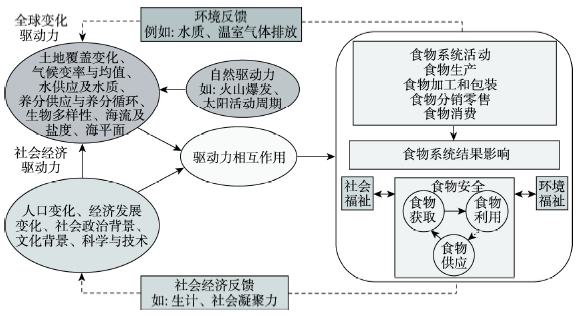

城市化背景下食物系统耦合研究的理论框架及优先方向
|
马恩朴(1989-), 男, 贵州毕节人, 博士, 讲师, 研究方向为人地系统耦合、食物系统与城乡可持续发展。E-mail: maenpu2015@sina.com |
收稿日期: 2020-05-11
要求修回日期: 2021-04-20
网络出版日期: 2021-12-22
基金资助
国家自然科学基金项目(71734001)
国家自然科学基金项目(41971224)
版权
Theoretical framework and research priorities on food system couplings in an urbanization context
Received date: 2020-05-11
Request revised date: 2021-04-20
Online published: 2021-12-22
Supported by
National Natural Science Foundation of China(71734001)
National Natural Science Foundation of China(41971224)
Copyright
受城市化、地域功能分化、生产要素优化配置和交通网络快速扩展等因素影响,区域之间资源要素的流动已成为区域可持续发展的内在需求。在这种背景下,人类与地理环境互动模式的网络化就要求地理学研究采取全程耦合范式,即将区域内部、区域与周边区域、以及非邻接区域之间的人地互动同时纳入考虑。食物系统作为衔接乡村与城市、以及产地与全球消费市场的产业链和价值链,是开展人地系统近远程耦合研究的重要切入点。基于这种认识,本文在论证理论研究内在依据及外在条件的基础上,将食物系统的构成要素与远程耦合框架相结合,建立“城市化驱动下食物系统近远程耦合的理论框架”并论述该理论框架的具体内涵。以拓展理论框架中的前沿领域为基本导向并结合国家重大战略需求,本文进一步明确了食物系统耦合研究的基本问题和4个亟待突破的优先研究方向。其中,基本问题是食物域的格局特征、时空演化及其动力机制。4个优先方向则包括:耦合社会经济文化变迁与生物地球化学循环的供应链网络人地互动研究;食物系统近远程耦合效应及其调控策略研究;基于食物系统的城乡融合与长效脱贫机制研究;以及面向公共卫生安全的食物系统跨区域、多层次治理研究。本文最后设计了食物系统耦合研究的一般技术路径,研究结果可为进一步的案例实证提供理论支撑和研究思路参考。

马恩朴 , 蔡建明 , 郭华 , 林静 , 廖柳文 , 韩燕 . 城市化背景下食物系统耦合研究的理论框架及优先方向[J]. 地理学报, 2021 , 76(10) : 2343 -2359 . DOI: 10.11821/dlxb202110002
Driven by urbanization, regional functional differentiation, optimal allocation of production factors, and rapid expansion of transportation networks, the flow of resources between regions has become a key impetus for regional sustainable development. Hence, the interaction networking between human beings and their natural environment requires a meta-coupling paradigm research from a geographic perspective, that is, to consider the human-nature interactions within the region, between the region and surrounding regions, and between non-adjacent regions simultaneously. As an industrial chain and value chain that connects rural areas and cities, as well as production areas and global consumer markets, the research on food system couplings is a good and important entry point for a better understanding the interactions and networking in the human-earth system. With this perspective in mind and aiming at demonstrating the theoretical study based on internal basis and external conditions, this paper combines the food system components with the tele-coupling framework to establish a "theoretical framework of local and tele-coupling of food systems driven by urbanization", and discusses the specific connotation of the theoretical framework. Taking the extension of the frontier fields in the theoretical framework as the basic guide and combining China's major strategic needs, the paper further identifies the basic issues for food system coupling research and four priority research directions that need to be breakthrough. Among them, the pattern characteristics, the spatio-temporal evolution and its driving mechanism of foodshed are the basic issues, while the four research priorities include: human-nature interaction research of the supply chain network coupling socio-economic and cultural changes and biogeochemical cycles; effects of the local and tele-coupling of food system and its regulatory strategies; the mechanism of urban-rural integration and long-term poverty alleviation based on food system; and cross-regional multi-level governance of food systems for public health and food security. A general technical methodology of the food system coupling research is designed at the end of the paper. The conceptual framework and methodology in this paper can provide theoretical guideline and enlightenment for further food system coupling research and other similar studies.

表1 食物系统综合调控的“工具箱”Tab. 1 “Toolbox” for comprehensive regulation of food systems |
| 调控环节 | 生产端调控 | 供应链管理 | 消费端调控 |
|---|---|---|---|
| 调控工具 | ·农业主产区雨洪调节与利用系统 ·水肥一体化滴灌与测土个性配肥 ·农业区块链技术与数字农业系统 ·农业用水超限额阶梯水费制度 ·农业结构、政策与生产方式转型 ·…… | ·无公害农产品认证 ·绿色、有机食品认证 ·农产品地理标志认证 ·农产品认证有效性监督 ·农产品环境标签制度 ·…… | ·可食用景观规划 ·建立地方食物系统 ·制定《负责任消费指南》 ·制定《居民膳食指南》 ·开展食物-健康-环境教育 ·…… |
| [1] |
[ 马恩朴, 蔡建明, 林静, 等. 2000—2014年全球粮食安全格局的时空演化及影响因素. 地理学报, 2020, 75(2):332-347.]
|
| [2] |
[ 郭华, 王灵恩. 国外食物系统研究综述及借鉴. 自然资源学报, 2018, 33(6):992-1002.]
|
| [3] |
[ 赵文武, 侯焱臻, 刘焱序. 人地系统耦合与可持续发展: 框架与进展. 科技导报, 2020, 38(13):25-31.]
|
| [4] |
[ 马恩朴, 蔡建明, 韩燕, 等. 人地系统远程耦合的研究进展与展望. 地理科学进展, 2020, 39(2):310-326.]
|
| [5] |
[ 樊杰. 我国主体功能区划的科学基础. 地理学报, 2007, 62(4):339-350.]
|
| [6] |
[ 樊杰. 人地系统可持续过程、格局的前沿探索. 地理学报, 2014, 69(8):1060-1068.]
|
| [7] |
[ 樊杰. 中国主体功能区划方案. 地理学报, 2015, 70(2):186-201.]
|
| [8] |
[ 樊杰, 蒋子龙. 面向“未来地球”计划的区域可持续发展系统解决方案研究: 对人文—经济地理学发展导向的讨论. 地理科学进展, 2015, 34(1):1-9.]
|
| [9] |
[ 苏红键. 空间分工、专业化与集聚经济. 北京: 社会科学文献出版社, 2016: 1-83.]
|
| [10] |
[ 金凤君, 陈卓. 1978年改革开放以来中国交通地理格局演变与规律. 地理学报, 2019, 74(10):1941-1961.]
|
| [11] |
|
| [12] |
|
| [13] |
|
| [14] |
[ 方创琳, 周成虎, 顾朝林, 等. 特大城市群地区城镇化与生态环境交互耦合效应解析的理论框架及技术路径. 地理学报, 2016, 71(4):531-550.]
|
| [15] |
|
| [16] |
[ 方创琳, 任宇飞. 京津冀城市群地区城镇化与生态环境近远程耦合能值代谢效率及环境压力分析. 中国科学: 地球科学, 2017, 47(7):833-846.]
|
| [17] |
[ 刘海猛, 方创琳, 李咏红. 城镇化与生态环境“耦合魔方”的基本概念及框架. 地理学报, 2019, 74(8):1489-1507.]
|
| [18] |
[ 马恩朴, 蔡建明, 林静, 等. 远程耦合视角下的土地利用/覆被变化解释. 地理学报, 2019, 74(3):421-431.]
|
| [19] |
[ 任宇飞, 方创琳, 孙思奥, 等. 城镇化与生态环境近远程耦合关系研究进展. 地理学报, 2020, 75(3):589-606.]
|
| [20] |
[ 郭华, 王灵恩, 马恩朴. 食物系统认知进展及其地理学研究范式探讨. 地理科学进展, 2019, 38(7):1034-1044.]
|
| [21] |
|
| [22] |
|
| [23] |
|
| [24] |
|
| [25] |
|
| [26] |
|
| [27] |
Food and Agriculture Organization of the United Nations. City Region Food System: Tools/Examples Rome: Food and Agriculture Organization of the United Nations, RUAF Foundation, Wilfrid Laurier University, Centre for Sustainable Food Systems, 2018.
|
| [28] |
|
| [29] |
|
| [30] |
|
| [31] |
|
| [32] |
|
| [33] |
|
| [34] |
|
| [35] |
|
| [36] |
|
| [37] |
|
| [38] |
|
| [39] |
|
| [40] |
|
| [41] |
|
| [42] |
|
| [43] |
|
| [44] |
|
| [45] |
|
| [46] |
|
| [47] |
|
| [48] |
[ 魏静, 马林, 路光, 等. 城镇化对我国食物消费系统氮素流动及循环利用的影响. 生态学报, 2008, 28(3):1016-1025.]
|
| [49] |
|
| [50] |
[ 慕亚芹, 李群, 崔江浩. 土壤—植物营养学家朱兆良先生的科学研究与贡献. 土壤, 2017, 49(1):1-6.]
|
| [51] |
|
| [52] |
[ H·巴赫, 等. 全球气候变化背景下跨界流域水、能源和粮食安全的合作. 水利水电快报, 2016, 37(8):1-7.]
|
| [53] |
Food and Agriculture Organization of the United Nations. Bioenergy and food security. China Agricultural Information, 2008(6):4-6.
[联合国粮食及农业组织. 生物能源与粮食安全. 中国农业信息, 2008(6):4-6.]
|
| [54] |
[ 蔡建明, 马恩朴, 林静. 乡村振兴的本质是城乡融合. 城市, 2019, 11:3-12.]
|
| [55] |
|
| [56] |
|
| [57] |
|
/
| 〈 |
|
〉 |